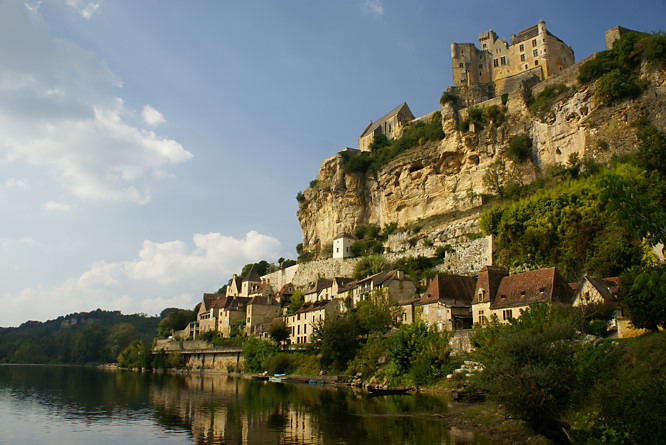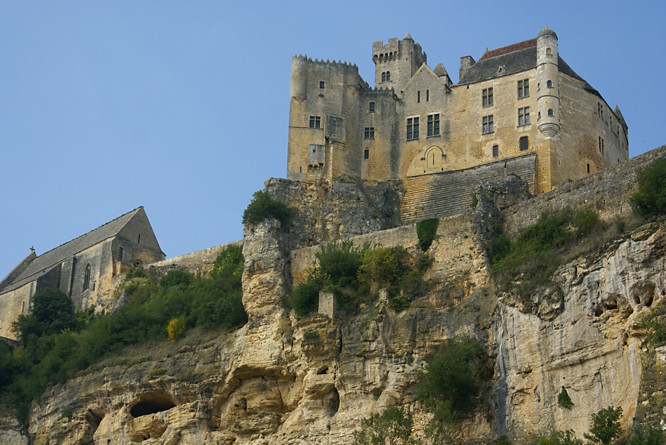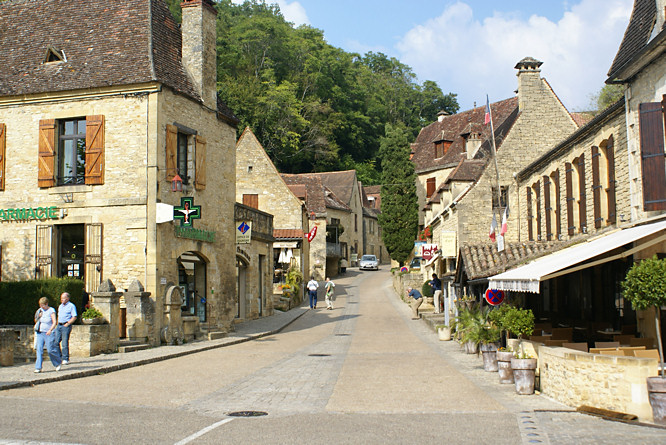Beynac et Cazenac in the Dordogne
Beynac-et-Cazenac is on the list of 'most beautiful villages of the Dordogne' and can be found on the banks of the Dordogne River, 8 km south-west of Sarlat la Caneda. Beynac is more correctly called 'Beynac-et-Cazenac', (Cazenac being its close neighbour).

Beynac-et-Cazenac is truly a 'picture postcard' village set in a magnificent location. Its row of attractive warm yellow sandstone riverside houses are squeezed between the Dordogne river and towering overhanging cliffs. Beynac-et-Cazenac is in my top three 'must see places' in the Dordogne region of France along with Sarlat and La Roque-Gageac.
If you just put in Beynac in your satellite navigation equipment it will take you to the wrong place. Make sure you are heading towards the correct Beynac. The very charming attractive village of Beynac is spread along the northern bank of the Dordogne river, and then winds up the hill to the chateau perched above.
There are car parks at both ends of the village by the riverbank. Most of the cafes and shops are at the western end of the village. Apart from the noise of the traffic Beynac cafes are the ideal place to spend a relaxing hour or so watching the locals and tourist wandering around the local streets.

The steep narrow lanes winding up through the traditional Dordogne honey-coloured buildings, some built into the cliff face, are wonderful to explore. If you have problems climbing hills then stick to the riverbank road. You can walk through these alleyways up to the castle on top of the cliff if you are fit. Most tourist choose to get to the castle by car or coach but parking is limited and can be difficult during the school holiday period in the summer.
The town's castle Chateau de Beynac has been used as a location in many films. It's current tranquil location overlooking the sleepy town of Beynac and the slow calm flowing river Dordogne are in stark contrast to the turbulent battles it has known in the past. It has a long and eventful history, Chateau de Beynac played an important role in the Hundred Years War and the Wars of religion.
Especially in the 13th century it was the setting for many grim battles as two opposing barons - Casnac and Beynac - fought for control of the region. In 1214 the castle was seized from Bernard de Casnac, who then regained it a year later and hanged all members of the occupying garrison. He was the driven out again, this time by the Archbishop of Bordeaux, who ordered the castle be burned.

Beynac Chateau was a French stronghold, while the English had to make do with the equally magnificent Chateau de Castelnaud on the other side of the river. King Richard the Lionheart is believed to have seized the castle by scaling the cliffs below and entering through the 'toilet holes' that are suspended out over the cliff. Now that is a smelly story to tell the children.
Chateau Beynac is a fascinating castle to visit and explore. Its impressive defensive location is to be admired as well as the views from the high castle walls. You can see miles of surrounding Dordogne countryside. Several of the Chateau's ancient rooms have been opened to the public including the dungeons, kitchens, castle living quarters as well as the various open courtyards. You can also visit the Museum of Medieval Warfare within in the castle. Here you can view and learn about wide range of medieval armoury.
Travel books

